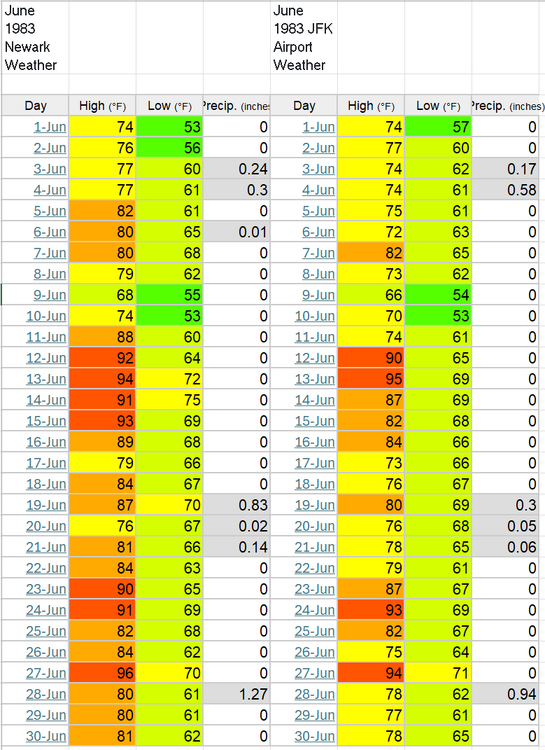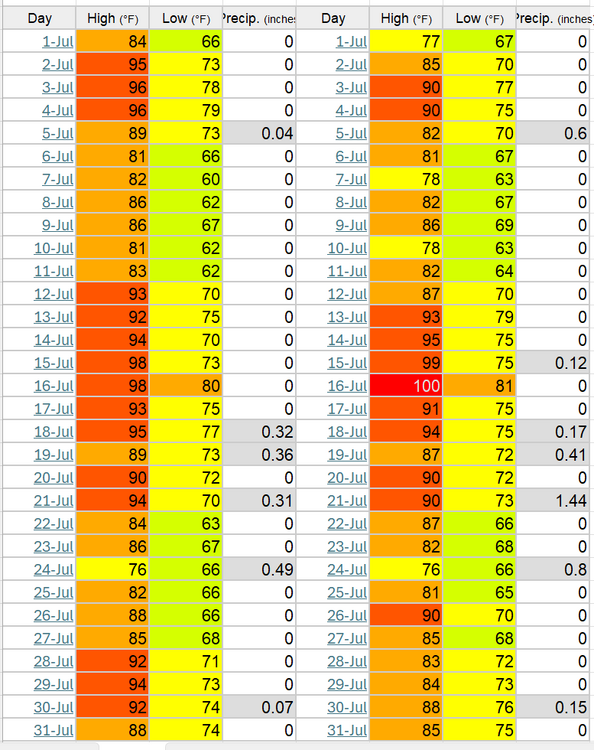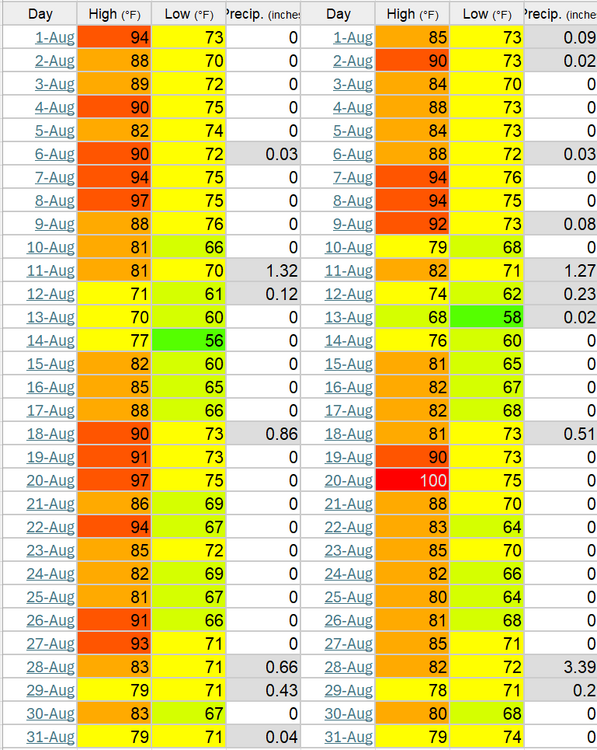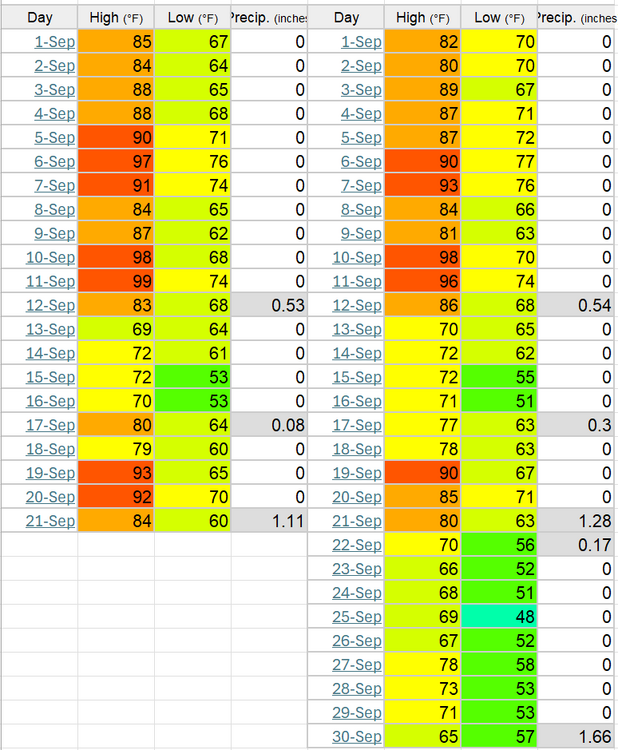
SACRUS
Members-
Posts
14,072 -
Joined
-
Last visited
Content Type
Profiles
Blogs
Forums
American Weather
Media Demo
Store
Gallery
Everything posted by SACRUS
-
Expanded data back to 2010 - looks like Mon, Tue then 8/10 and beyond could add to those - no strong heat (95+) but do see plenty of 88 - 91 days through the 13/14th before perhaps more sustained warmth / heat towards the middle , second half of august. EWR can get there with a N/NNE/E with right amount of sun.
-
Records: Highs: EWR: 101 (2006) NYC: 97 (2005) LGA: 100 (2006) JFK: 99 (2006) Lows: EWR: 57 (1953) NYC: 55 (1927) LGA: 59 (1953) JFK: 56 (1964) Historical: 1864: A waterspout over Albemarle Sound, NC passed perilously close to the Union Fleet at anchor. The crews of the ships watched "in awe" as the whirlwind dissipated as it moved onshore. (Ref. Wilson Wx. History) 1885 - A tornado hit Philadelphia and Camden along its eight mile path. (David Ludlum) 1885: A tornado causing estimated F3 damage hit Philadelphia and Camden along its eight-mile path. Six people were killed and damage totaled $500,000 dollars. Other tornadoes causing estimated F2 damage touched down in Cecil County, Maryland, New Castle County, Delaware and Bucks & Chester Counties in Pennsylvania. (David Ludlum) 1894: After two record heat waves in July, record cool weather arrives. Lansing, MI fell to 32° for a rare summer freezing temperature. (Ref. Wilson Wx. History) 1898: Philadelphia, PA had one of their worst thunderstorms ever when 5.84 inches fell in just 2 hours. The hydraulic pressure in the city sewers caused by the force of the accumulated runoff created overflows via toilets, basins, and sinks to rise to second floor levels in some cases. (Ref. AccWeather Weather History) 1899: A tropical depression was born in the tropical Atlantic. Before it finally dissipated a record 33 days later, it became known as the San Ciriaco Hurricane after a Puerto Rican village the storm devastated. Its life as a hurricane was 27.75 days, a record for the Atlantic Basin beating Hurricane Ginger of 1971 by three-quarters of a day. (Ref. Wilson Wx. History) 1960: A home in Wauponsee Township, IL was struck by two tornadoes within 4 hours. The first one struck around 7 PM and the second around 11 PM. The house sustained significant damage to the roof, wiring and appliances. (Ref. AccWeather Weather History) 1964: Muskegon, MI set an August record and tied their all-time record high temperature at 99°. The temperature hit 100° at Grand Rapids, MI a record for the date. Owen, WI set their all-time record high with 101°. (Ref. AccWeather Weather History) 1970 - Hurricane Celia struck the coast of Texas producing wind gusts to 161 mph at Corpus Christi, and estimated wind gusts of 180 mph at Arkansas Pass. The hurricane was the most destructive of record along the Texas coast causing 454 million dollars damage, and also claimed eleven lives. (David Ludlum) (The Weather Channel) 1974: Brooklyn, CT -- Lightning struck and killed a youth when he was running from a tent toward home at 2:40 a.m. (Ref. Lightning-The Underrated Killer.pdf) 1975: Boston, Massachusetts had a 83 °F temperature the warmest minimum temperature. (Highest minimum on Boston's records) (Ref. NOAA Boston Weather Events) 1981: Severe thunderstorms tore across portions of central and eastern South Dakota. Near Hoven, a steel bin building was lifted off the ground by a small tornado and carried about 30 feet before it wrapped around a tree. In Faulkton, winds gusted to 97 mph at the Faulkton airport. The extremely high winds destroyed an airport hanger and damaged a grain elevator. At Redfield, 70 mph winds leveled an outdoor movie screen and flipped a plane. (Ref. Wilson Wx. History) 1986: The minimum temperature of 69° is first below 70 °F recorded in the past 28 days at DCA. (Ref. Washington Weather Records - KDCA) 1987 - A severe thunderstorm moved across Cheyenne, WY, during the mid afternoon. The thunderstorm produced hailstones up to two inches in diameter causing more than 37 million dollars damage. The eastern U.S. sweltered in the heat. A dozen cities reported record high temperatures for the date, including Paducah KY with a reading of 102 degrees. Beckley WV established an all- time record with an afternoon high of 93 degrees. (Storm Data) (The National Weather Summary) 1988 - Thunderstorms developing ahead of a slow moving cold front produced severe weather from the Central High Plains to the Upper Great Lakes Region. Thunderstorms around Fort Collins, CO, produced wind gusts to 74 mph along with marble size hail. Sixteen persons were injured in the storm, most of whom were accidently locked out of their office building, having evacuated it when the fire alarm went off, apparently triggered by lightning. (Storm Data) (The National Weather Summary) 1989 - Thunderstorms representing what remained of Hurricane Chantal drenched Wichita, KS, with 2.20 inches of rain in four hours during the early morning. Thunderstorms developing in Minnesota produced wind gusts to 85 mph at Baudette during the afternoon, and softball size hail at Lake Kabetogama, during the evening. Jamestown, ND, reported a record hot afternoon high of 103 degrees. (Storm Data) (The National Weather Summary) 1993: Chesterfield County, VA lightning struck and killed a 30-year-old man as he mowed his lawn. (Ref. Lightning - Virginia Weather History) Workers desperate to save the historic town of Prarier du Rocher, IL during the Mississippi River Flood deliberately broke a 1,000 foot hole in a levee near the town to divert water headed toward the town from a levee break upstream. The quick action worked, saving the town. (Ref. Wilson Wx. History) 1994: Fairbanks, AK recorded their hottest August temperature ever with 93°. (Ref. AccWeather Weather History) 1995: Hurricane Erin was nearing the coast of the Florida Panhandle. The hurricane had emerged into the Gulf Mexico the previous day after crossing the Florida Peninsula. By early morning, Erin's sustained winds reached 100 mph in a small area near its center. A 98-mph wind gust was observed at Mary Esther Field and Fort Walton Beach, FL. The storm came ashore near Pensacola, FL later that morning causing six fatalities and an estimated $700 million damage. The barrier island stretching from Pensacola Beach to Navarre Beach absorbed the brunt of the storm as it came ashore near Pensacola. Sustained winds of 94 mph and gusts up to 103 mph were measured at Pensacola during the height of the storm. Seven people were reported missing at sea. 2002: Two campers at Natural Chimneys Regional Park in Augusta County, VA were struck and injured by lightning. (Ref. Lightning - Virginia Weather History) 2003: Severe thunderstorms moved over parts of the Chicago Metro area during the early afternoon. The storms produced golf ball size hail along with heavy rain and flooding. 4.14 inches was reported in just 90 minutes six miles east of O’Hare Airport. Four to six feet of water covered the closed Kennedy Expressway. Several tents were blown down at an outdoor festival in Roselle. These storms continued into the evening producing more large hail. The National Weather Service at Romeoville reported nickel size hail for five minutes and 1.60 inches of rain in just 30 minutes. (Ref. Wilson Wx. History)
-
71 / 59 and another beaut of a day on tap. Warmer than yesterday by a few mid 80s. Monday warmer still with some inland areas to 90. With a similar Tue. Likely see clouds push back in on Wed from the south and clear out Thu, with the brunt of the rain down into MD and points outh. Overall near normal week - dry and lots of sunshine. Flow remains manly onshore the next 5 days with flow coming around more southerly with a warmer / hotter and wet overall next week. 8/3 - 8/8 : Near normal / below - dry overall - Wed/Thu clouds - rain looks to stay southwest 8/8 - beyond : Warm- Hot / Humid - wet overall - Tropics - heat for the area targeting the 9-12 period.
-
Records: Highs: EWR: 100 (2006) NYC: 100 (1955) LGA: 102 (2006) JFK: 98 (1975) Lows: EWR: 53 (1940) NYC: 57 (1875) LGA: 59 (1953) JFK: 59 (1985) Historical: 1944: A hurricane formed in the Bahamas and came ashore at the North Carolina/South Carolina border. It moved north as a tropical storm, then curved to the northeast, passing across the lower Delaware Bay on its way out to sea. Philadelphia, PA received 2.39 inches of rain and 0.22 inches on the 3rd. This was the first of three tropical systems to affect the Mid Atlantic states in 1944. (Ref. Wilson Wx. History) 1945: Washington, DC had 3.39 inches rain in 3 hours, 4.26 inches in 6 hours and 5.18 inches in 12 hours. (Ref. Washington Weather Records - KDCA) 1954 - Severe thunderstorms produced golf ball size hail for thirty minutes in north central Kansas. One drift measured 200 feet long, seventy feet wide and three feet deep. (The Weather Channel) 1964: Muskegon, Michigan records its hottest day ever with a reading of 99 °F. (Ref. WxDoctor) 1970: At least eight people drowned on Florida Panhandle beaches due to the effects of Hurricane Celia which passed hundreds of miles to the south and made landfall near Corpus Christi, TX. Rip tides and heavy surf with waves up to 10 feet pounded the beaches of Escambia, Okaloosa and Santa Rosa Counties. The Escambia County Sheriff reported 25-30 emergency calls with lifeguards rescuing at least 12 people. (Ref. Wilson Wx. History) 1974: 25 miles east of Buffalo, Wyo.--Lightning struck a party of fishermen, killing one and injuring four others. (Ref. Lightning-The Underrated Killer.pdf) 1975 - Record heat gripped New England. Highs of 104 degrees at Providence, RI, and 107 degrees at Chester and New Bedford, MA, established state records. The heat along the coast of Maine was unprecedented, with afternoon highs of 101 degrees at Bar Harbor and 104 degrees at Jonesboro. (The Weather Channel) Boston, Massachusetts had a 102 °F temperature the warmest temperature for August. (Ref. NOAA Boston Weather Events) 1978: Very heavy rains of 12 to 14 inches fell across the Texas Hill Country during the nighttime and early morning hours causing severe flooding on the Guadalupe River. Up to 30 inches of rain fell during the 3-day period from the 1st through the 3rd. 27 people died in the Hill Country flooding along with tens of millions of dollars in damage. More flooding occurred during the early evening near Abilene, where six people were killed. (Ref. Wilson Wx. History) 1980: The intense heat wave continued in Texas. Dallas had their 41st consecutive day of 100° readings. The streak eventually reached 42 days. Abilene, TX was on their 41st consecutive day of 98° or higher, tying a record that dated back to 1952. El Paso, TX was on their 51st consecutive day of 100°+ temperatures. Other record highs included: Oklahoma City, OK: 110°, Tulsa, OK: 108° and Springfield, MO: 102°. (Ref. Wilson Wx. History) 1985: A strong and sudden wind gusts cause a plane crash at the Dallas/Fort Worth Airport in Texas that kills 135 people. The rapid and unexpected formation of a supercell, an incredibly powerful form of a thunderstorm, led to the tragedy. 1987 - Hot weather continued in the central U.S. Fifteen cities reported record high temperatures for the date, including Concordia KS with a reading of 106 degrees, and Downtown Kansas City, MO, with a high of 105 degrees. Evening thunderstorms produced severe weather in the Ohio Valley and the north central U.S. Thunder- storms in South Dakota produced wind gusts to 70 mph at Philip, and hail two inches in diameter at Faulkton. (Storm Data) (The National Weather Summary) 1988 - Searing heat continued from the Middle and Upper Mississippi Valley to the Middle and Northern Atlantic Coast States. Twenty- six cities reported record high temperatures for the date. Chicago IL reported a record seven days of 100 degree heat for the year. (The National Weather Summary) 1989 - Low pressure representing the remains of Hurricane Chantal deluged north central Texas with heavy rain. Up to 6.50 inches drenched Stephens County, and Wichita Falls reported 2.22 inches of rain in just one hour. Bismarck, ND, reported a record warm morning low of 75 degrees, and record hot afternoon high of 101 degrees, and evening thunderstorms in North Dakota produced wind gusts to 78 mph at Lakota. Early evening thunderstorms in Florida produced high winds which downed trees at Christmas. (Storm Data) (The National Weather Summary) 1995: Hurricane Erin made landfall near Sebastian Inlet in southern Brevard County during the early morning hours. Brevard County bore the brunt of the storm with wind gusts to 100 mph between Melbourne Beach and Cocoa Beach knocking down trees on houses, cars, and power lines. As Erin moved through Orlando during the morning wind gusts to 60 mph downed trees on power lines, houses and cars. About one-half million people were without power initially, several thousand were without power for more than five days. Heavy rains of up to 8 inches in three hours on the backside of Erin hit Brevard County again during the afternoon causing widespread flooding of low lying areas. Erin moved into the Gulf of Mexico during the afternoon as a tropical storm, but regained hurricane strength. Erin then made a second Florida landfall near Pensacola on the morning of the 4th with sustained winds of 95 mph gusting to 110 mph. Damage in the Pensacola area was estimated at $300 million dollars. (Ref. Wilson Wx. History) 1996: Powerful thunderstorms moved across southwest and south central Kansas during the evening hours. In Pratt county eight train cars were blown off the tracks while the train was moving. This occurred one mile west of Cullison. One family was nearly run over by the derailing train cars. One boxcar ended up about 10 feet away from their vehicle. From three miles south of Lewis to Belpre, very strong thunderstorm winds killed calves, blew cars off the highway and blew down 60 power poles. There were unofficial and unconfirmed reports of 125 mph winds recorded on home stations (Ref. Wilson Wx. History) 2000: Massive downburst winds estimated at 90 to 110 mph hit areas from eight miles west of Spearfish, SD to several miles east of Spearfish. Hail, to golf ball size accompanied the high winds and damaged roofs and siding throughout the region, although the winds caused the worst damage. The airport at Spearfish had 27 planes damaged, and seven of those were destroyed beyond repair. Seven hangers at the airport were also damaged or destroyed. Roofing material sliced through an oxygen valve at the Spearfish Trout Farm and killed 100,000 out of 120,000 trout that the family raised. In the Spearfish city campground, more than 150 campers were there, in anticipation of the 60th Annual Sturgis Motorcycle Rally the following week. None of the trees fell on occupied tents, although several fell within inches of where people were sleeping in their tents. In Rapid City, the National Weather Service office measured wind gusts of 70 mph. The storm weakened as it moved southeast of Rapid City, but was still at severe limits as it passed over the Badlands National Park and went southward into Bennett County. Observers in Martin reported 60 mph wind gusts. (Ref. Wilson Wx. History) 2001: Chicago Illinois was pounded by up to 3.50 inches of rain in one hour in the a.m. rush; some interstate expressways were under 8 feet deep water. Some 228 stalled vehicles had to be towed. 10,000 homes had water damage; 50,000 customers without power at the peak of the storm. (Weather Guide Calendar with Phenomenal Weather Events 2007 Accord Publishing, USA) (Ref. WxDoctor) 2008: Denver, Colorado: A 130-year-old high-temperature record falls in Denver, when the mercury hit 103 °F. (Ref. WxDoctor)
-
67 / 59 . Clear and gorgeous out. Low - mid 80s today. Same maybe a touch warmer tomorrow. Mid - upper 80s Monday, perhaps 90 in the hot areas inland NJ. Overall near normal the next week with a onshore barrage. Wed/THu still watch if rain make it north of DE/NJ but lookig dry. Atlantic ridge hovering off the east coast, ridge back west and northeast. Flow comes around by next weekend with a warm - hot / humid wet overall into the beyond.
-
July 2025 Discussion-OBS - seasonable summer variability
SACRUS replied to wdrag's topic in New York City Metro
EWR: +3.9 (82.1) Rain: 4.04 4 days below normal , 1 at normal, 20 90 degree days Mac 101 / min 65








